Hockey drills for technique warming-up
- Players outside the box should replay as often as possible.
- The pass must always pass through the box.
- The players inside the box must try to intercept the ball.
- As soon as the players inside the box have intercepted the ball, they should replay as often as possible inside the box.
- Each time they have replayed 3 times, someone outside the box may enter the box to recapture the ball.
- As soon as they succeed, they will play to someone outside the box and it will start over again, so at least one player must always remain outside the box to be able to play.
- The field can be larger or smaller, there can be more or less players inside and outside the box.
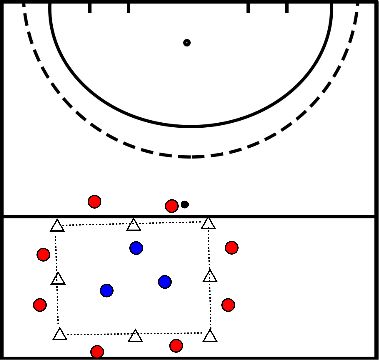
Make 2 teams.
- Both teams have their 'own' course, where they can score points (for example by playing over 5 times in their own course).
- The other team is allowed to conquer the ball in the other box, but not everyone from the other team is allowed to enter the other box.
- The number of players of the other team -1.
- As soon as blue has captured the ball, blue will go to his own square as soon as possible and will play over there as often as possible.
- There may be 3 players of red in the blue box.
- See example: in team red there are 4 players, so 3 players of blue are allowed to enter the red box.
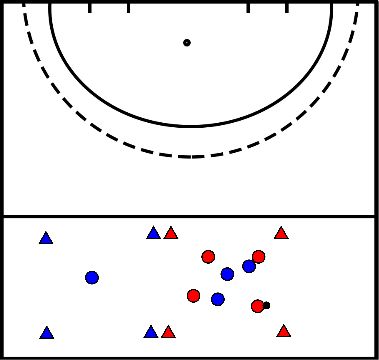
- Goal: to show the player when it is best to pass and when it is best to push.
- In case of a long pass you pass, in case of a short pass you push.
- Player 1 passes (long pass) the ball to player 2
- Player 2 pushes (short pass) the ball to player 3.
- Player 3 passes (long pass) the ball to player 4.
- Player 4 pushes (short pass) the ball to player 5.
- Player 5 passes (long pass) the ball to player 6.
- Player 6 pushes (short pass) the ball to player 7.
- Player 7 runs along the red pilons to the back line and passes (long pass) the ball to player 8, who has entered the circle.
- When explaining the exercise, you can let the player fill in whether it's a long or short pass and what kind of stroke you use, this way they will actively think about it and will apply it earlier in the game.
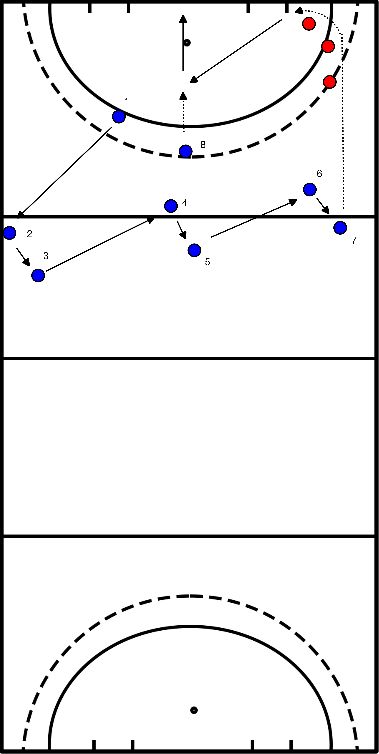
- Make 2 teams.
- From each team place 2 players outside the box opposite each other.
- The ball starts with one of the players outside the box (in the example red).
- As a team you get a point to play from one side to the other, through the players in the box.
- Make the box smaller to make it more difficult or with fewer players.
- Make the box larger to make it easier or with more players.
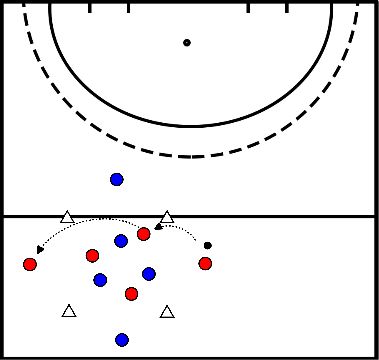
- Player 1 walks to the right pole of the goal
- Player 2 plays the ball towards the blue pilon and allows player 1 to tip the ball in the loop.
- Player 2 runs to the left pole of the goal
- Player 3 plays the ball towards the red pilon and allows player 2 to tip the ball in the loop
- By swapping:
- 1 --> 2
- 2 --> 3
- 3--> 1
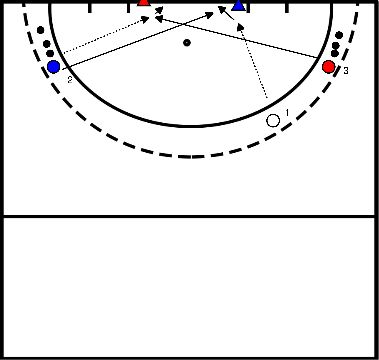
- All players are facing the back line.
- Player 1 plays the ball in the backhand of player 2.
- Player 1 catches up with the other players on the left.
- Player 2 plays the ball into player 3's backhand.
- Player 2 overtakes the other player on the left.
- Player 3 plays the ball into player 1's backhand.
- Continue until you reach the back line and turn around.
- Points of attention:
- Make sure everyone keeps watching the ball at all times. Especially when the ball is behind you and at that moment the ball is played to you.
- Make sure you always keep moving.
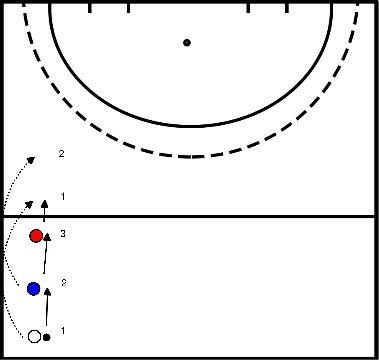
series of exercises to train postural muscles
- hip crossover
- scorpion
- one-hundred
- left hand on right knee, right hand on right ankle, stretched left leg (15 cm off the ground), shoulders off the ground -> alternate: right hand on left knee, left hand on left ankle, stretched right leg. Slow movement!
- On hands/knees (shoulders - trunk - legs rectangle). Right leg and right arm open towards ceiling, hips on top of each other. Turning back from here, dogpose, swing left leg up, back to hands/knees. Repeat! Ditto left.
- Lateral posture, upper leg stretched back, upper arm stretched forward. Bring hand to knee and extend again. Repeat! Same other side.
- Sitting on right hip, right hand on ground. From here up with left leg stretched towards ceiling and back again. Repeat! Same left.
- board position. From there, put foot for foot next to your hand and back again. Sequence: first right first, then left first (turn around).
- Everybody's got a ball, you're facing each other on the 23-metre line.
- Left and right is a line of pilons.
- The ball is light under your legs, at some point the trainer tells you how to stand (on your left leg, or touch your ankles) then the trainer calls left or right and you have to run to that side as quickly as possible and the ball must lie still on the line with pilons,
- If the ball is still on the line, run back to the 23-metre line as quickly as possible.
- Whoever is first wins.
- The pilons are about 3 or 4 metres from the 23 metre line, on both sides.
- You're facing each other with the ball in the middle,
- the trainer calls head, shoulder, hip, knee and toe as many times as you like and then, at some point, takes the ball and then the players have to take a ball as quickly as possible too.
- Only 1 can win.
Place 15 to 20 pylons over a distance of about 40 metres from the rear line towards the middle line, in a straight line. The spacing between them at the basic form is 2 meters.
Make 2 rows that are positioned behind the back line. The players do their exercise on both sides of the pylons at the same time towards the end of the series of pylons. There they turn and dribble with a wide curve back to the beginning. When the first two are at the fourth pylon, the next two can start.
Put players with an equal physical capacity next to each other. You can do a positional approach (defender versus defender, attacker versus attacker).
Exercise
1. On the signal the front 2 players start.
2. Sprint each time 2 pylons forward and then 1 pylon backward.
3. Keep your face forward, so don't turn during the exercise.
4. The intensity is 90% of the maximum capacity. Especially the forward runs (starting away) must be explosive and with short steps.
5. At the end of the series of pylons you turn with a wide bend and dribble easily back to the starting point.
6. Repeat this exercise once.
Variations
1. Identical to the basic form, but now with the pylons in a different pattern: between the first 2 pylons is 1 meter, between the next 2 meters, then 3 meters, 4 meters and finally 5 meters. After this you go down again (respectively 4, 3, 2 and 1 meter space between the pylons). In total you will have 18 pylons.
2. Identical to the basic form, but now with a different pattern: between the first 3 pylons 1 meter, the next 2 pylons 5 meter, then again 3 pylons with 1 meter, 2 pylons with 5 meter. After this, place the same pattern again (4 times the same pattern in 1 line, with a total of 18 pylons).
3. Identical to variation 3, but now you don't place the pylons in a straight line, but in curves.
4. You make a straight line of pylons and arrange them as you see fit. Make sure there is a lot of variation.
5. Identical to variation 4, but now with faint curves.
Intensity of the exercise
The intensity is 90% of the maximum effort. Panting, should be motivated execution with highly explosive character in the runs with a maintained body control and athletic posture, EMI 7/8.
- The tagger should try to tap as many children as possible.
- If you are in danger of getting tapped you can call a television show and then the tagger is not allowed to tap you.
- You have to stand with your legs wide.
- The rest can be relieved by crawling between your legs.
- When you are tapped, you stand by the trainer.

- 2 players give each other a hand and start tapping together (don't let go).
- Player who is tapped gives a 3rd hand and when another player is tapped they form another twin pair.
(each group of four splits).








